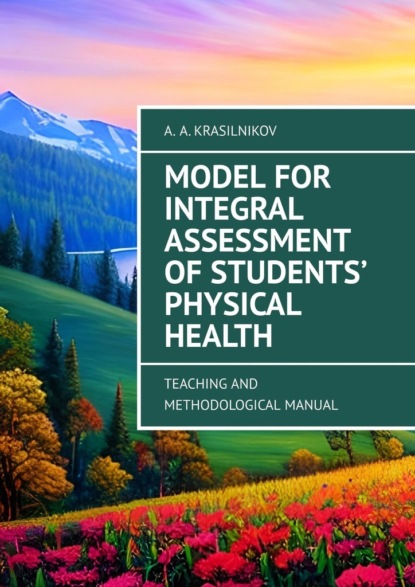По всем вопросам обращайтесь на: info@litportal.ru
(©) 2003-2024.
✖
Model for Integral Assessment of Students’ Physical Health. Teaching and Methodological Manual
Год написания книги
2023
Настройки чтения
Размер шрифта
Высота строк
Поля
According to the commonly accepted classification, primary lung volumes are combined into so-called lung capacities, of which there are also four. The most commonly used in practice to assess a person’s physical development is the vital capacity of the lungs (VCL) – the amount of air that can be exhaled from the lungs after a maximum inhalation. VCL consists of three volumes: VCL = tidal volume (TV) + inspiratory reserve volume (IRV) + expiratory reserve volume (ERV).
1.1. Assessment of physiometric indicators
Vital Capacity (VC)
The normal value of VC depends on the person’s gender and age, body type, physical development, and may significantly decrease in various illnesses, reducing the body’s ability to adapt to physical stress.
In men, the normal VC is calculated at 60 milliliters per 1 kilogram of weight for non-athletes and 65 milliliters or more for athletes, while in women, it is 50 and 55 milliliters, respectively. The average VC is about 2.5—4 liters for women and 3.5—5 liters for men. Absolute VC values are not very informative due to individual variability. It is recommended to calculate «due» values when assessing the condition.
Calculation of the predicted lung capacity (PLC) in liters:
PLC for men = 5.2 x H – 0.029 x A – 3.2
PLC for women = 4.9 x H – 0.019 x A – 3.76
H – height in meters, A – age in years.
The actual lung capacity is considered reduced if it is less than 80% of the PLC. Lung capacity indirectly reflects the size of the respiratory surface of the lungs, where gas exchange occurs between alveolar air and blood in pulmonary capillaries. In other words, the larger the lung capacity, the greater the respiratory surface of the lungs. In addition, the larger the lung capacity, the deeper the breath and the easier it is to achieve an increase in ventilation volume. Thus, lung capacity determines the ability of the body to adapt to physical exertion, to a lack of oxygen in the inhaled air (for example, when ascending to altitude). Lung capacity is an indicator that largely determines the functional capabilities of the external respiratory system. A decrease in lung capacity always indicates some pathology. Lung capacity cannot and should not be considered the only indicator of increased function of the external respiratory system. It only determines the functional capabilities of this system in terms of providing the body with the necessary amount of oxygen. Therefore, the potential capabilities of the external respiratory system in a person with high lung capacity are higher (larger respiratory surface and the ability to deepen breathing) than in a person with low lung capacity.
Recommendations for low JEL levels:
1. During the learning process: frequent ventilation of the room and physical activity during breaks aimed at working the main and auxiliary respiratory muscles.
2. Increase time spent in forest-park zones. Reduce or eliminate harmful habits such as smoking, as this leads to a reduction in the synthesis of surfactant on the inner surface of lung alveoli, which prevents their collapse.
3. Include complete proteins and fats in the diet that restore surfactant in lung alveoli.
4. Include daily aerobic physical activity, outdoors for at least 30 minutes. Use types of motor activity that train the respiratory system according to personal choice. Include various breathing exercises.
5. Keeping health diaries to monitor daily routine, training, and body condition.
Hand Muscle Strength
Normally, the average strength of the right hand muscles (for right-handed individuals) is 35—50 kg for men and 25—33 kg for women. The average strength of the left hand muscles is usually 5—10 kg less than that of the right hand.
Any measure of strength is usually closely related to the volume of muscle mass, i.e. body mass. Therefore, when evaluating the results of dynamometry, it is important to consider both the main absolute strength (i.e. the value shown by the dynamometer) and the relative strength, i.e. relative to body mass. Relative strength is expressed as a percentage. To calculate it, the value of the strength of the right hand is multiplied by 100 and divided by the body mass value. Decreased strength can occur due to illness, negative mood, fatigue, disruption of the motor mode, aging, etc.






